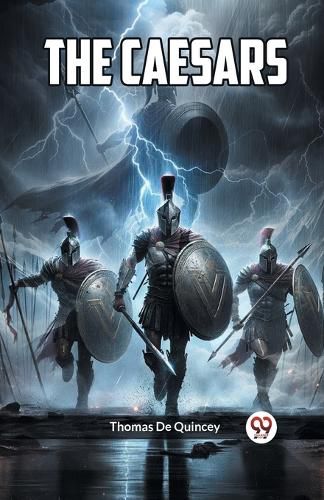Readings Newsletter
Become a Readings Member to make your shopping experience even easier.
Sign in or sign up for free!
You’re not far away from qualifying for FREE standard shipping within Australia
You’ve qualified for FREE standard shipping within Australia
The cart is loading…






This title is printed to order. This book may have been self-published. If so, we cannot guarantee the quality of the content. In the main most books will have gone through the editing process however some may not. We therefore suggest that you be aware of this before ordering this book. If in doubt check either the author or publisher’s details as we are unable to accept any returns unless they are faulty. Please contact us if you have any questions.
"The Caesars" by Thomas De Quincey is a historical and psychological essay that delves into the lives of the Roman emperors, inspecting their characters and the impact of energy on their personalities. De Quincey's paintings provides a unique angle at the Roman Empire, exploring the psychological complexities of its rulers. The essay unfolds as a chain of vivid character sketches, with De Quincey employing his eloquent prose to dissect the psyches of numerous emperors, together with Julius Caesar, Augustus, and Nero. De Quincey intertwines historical statistics with speculative analyses, supplying readers a compelling mixture of authentic information and ingenious interpretation. Throughout "The Caesars," De Quincey explores the effects of absolute strength on the human thoughts, scrutinizing the ethical and mental variations gone through with the aid of those historical figures. His narrative style, characterized by using a rich and nuanced language, engages readers in a notion-scary exploration of the dynamics between power, ambition, and the human psyche. As an influential essayist and literary critic of the 19th century, Thomas De Quincey brings his intellectual prowess to bear on the look at of records in "The Caesars," providing readers with a fascinating and insightful journey into the minds of a number of the maximum effective figures in historic Rome.
$9.00 standard shipping within Australia
FREE standard shipping within Australia for orders over $100.00
Express & International shipping calculated at checkout
This title is printed to order. This book may have been self-published. If so, we cannot guarantee the quality of the content. In the main most books will have gone through the editing process however some may not. We therefore suggest that you be aware of this before ordering this book. If in doubt check either the author or publisher’s details as we are unable to accept any returns unless they are faulty. Please contact us if you have any questions.
"The Caesars" by Thomas De Quincey is a historical and psychological essay that delves into the lives of the Roman emperors, inspecting their characters and the impact of energy on their personalities. De Quincey's paintings provides a unique angle at the Roman Empire, exploring the psychological complexities of its rulers. The essay unfolds as a chain of vivid character sketches, with De Quincey employing his eloquent prose to dissect the psyches of numerous emperors, together with Julius Caesar, Augustus, and Nero. De Quincey intertwines historical statistics with speculative analyses, supplying readers a compelling mixture of authentic information and ingenious interpretation. Throughout "The Caesars," De Quincey explores the effects of absolute strength on the human thoughts, scrutinizing the ethical and mental variations gone through with the aid of those historical figures. His narrative style, characterized by using a rich and nuanced language, engages readers in a notion-scary exploration of the dynamics between power, ambition, and the human psyche. As an influential essayist and literary critic of the 19th century, Thomas De Quincey brings his intellectual prowess to bear on the look at of records in "The Caesars," providing readers with a fascinating and insightful journey into the minds of a number of the maximum effective figures in historic Rome.